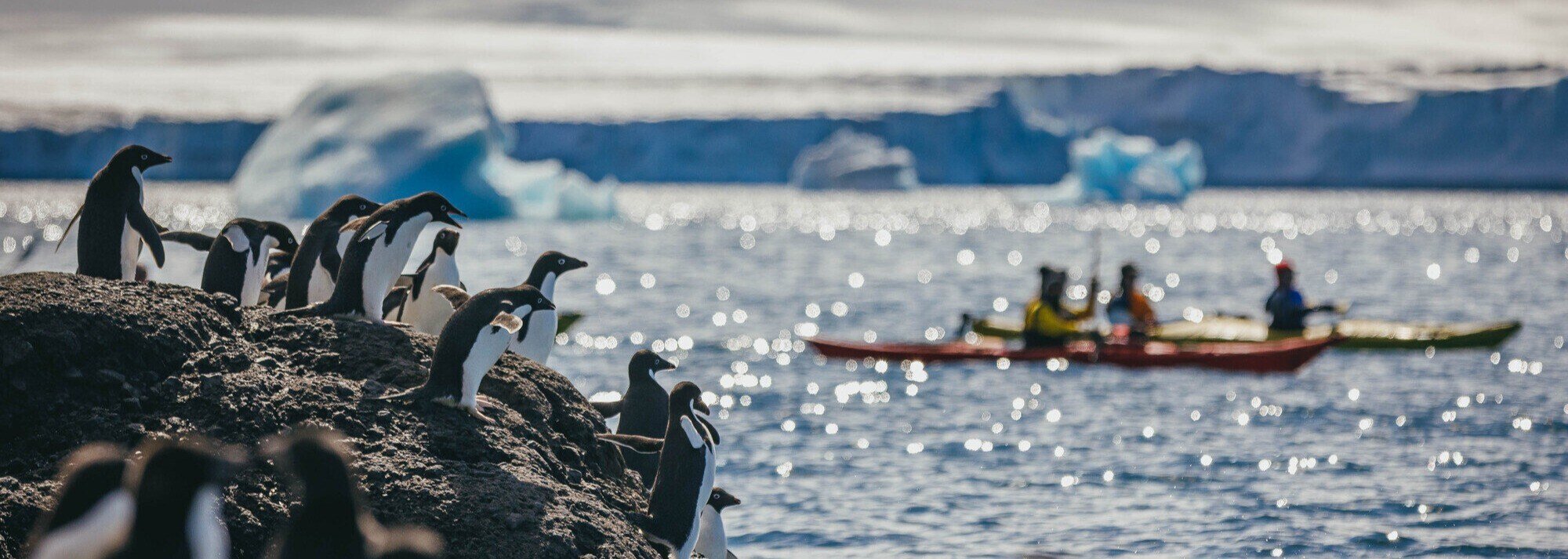How to Choose Between the Arctic and Antarctic - With Quark Expeditions
By TRAVELINK on January 30, 2025

The Arctic or Antarctica? Oh, life´s choices.
You’re not sure where the idea originated. Perhaps a documentary narrated by the British master of nature documentaries, David Attenborough, or perhaps the notion was prompted by a stunning photograph that popped up on Instagram. Then again, maybe it was a travel tale recounted by an adventurous friend who suggested you—yes you—could travel to the polar regions. The cold climates were unexpectedly calling you and now all that’s left for you is to choose: Arctic or the Antarctic? Read more about each region from our Virtuoso preferred partners at Quark Expeditions.

If you’re keen to see penguins, you’ll want to book yourself onto an Antarctic voyage.
There are no penguins in the Arctic. Photo: David Merron

It’s a simple strategy: for penguins you go to the Antarctic. For majestic polar bears,
you’ll want to join an Arctic expedition. Photo: David Merron
North or South? Down or Up? Where should I go?
Whichever Polar Region you choose, rest assured it will be fantastic and life changing. If you follow in the footsteps of great polar explorers like Roald Amundsen and James Clark Ross, it’s possible you’ll want to journey to both Polar Regions.
Choosing your Polar Region
The Arctic is an ocean surrounded by continents while Antarctica is a continent surrounded by ocean. We visit the Arctic in the northern hemisphere summer (June to October) and the Antarctic in the southern hemisphere summer (October to March). Trips vary anywhere from just over a week to nearly a month, so timing alone might determine your choice. And then within in each region there are sub regions and voyages that travel to those specific areas.
We can certainly help you decide by pointing out what each region has to offer.
The Arctic
Season: June to October.
What do you wish to see:
Wildlife: The Arctic has greater terrestrial and marine diversity than the Antarctic, however Arctic wildlife tends to be more elusive, partly because of polar bears and the long history of hunting.
Polar bears: While sightings aren´t guaranteed, your best chances to see these majestic animals are Svalbard, the Russian Arctic and the Canadian Arctic, in that order.
Whales: Guests will see whales in most regions though whale sightings are less predictable than in the Antarctic. Species visitors are likely to see include humpback whales, fin whales, minke whales, blue whales (though sightings are rare), killer whales (also called orca, but sighted infrequently), beluga whales (rare), bowhead whales (in the Canadian Arctic) and narwhal (very rare),

There are historical sites, former whaling stations and other landmarks throughout the Arctic. Photo: Grange Productions
Walruses: Svalbard, Russian Arctic and Canadian Arctic (in that order)
Inuit (Indigenous) communities: Visits to local communities are possible in Greenland and Arctic Canada.

The Arctic landscape can be surprisingly colorful, especially the tundra. Photo: Visit Greenland
Tundra: North of the treeline, where permafrost prevents trees from growing, is a vast ecosystem, bleak but beautiful, and while seemingly inhospitable and empty the tundra can reveal a surprising bounty of life.
North Pole: Travelers can visit 90º North—the very top of the world—on select voyages by icebreaker.
Crossing the Arctic Circle: An invisible line at 66º33´ North. Areas north of this line have at least one summer day on which the sun doesn´t set and one winter night when the sun never rises.
Glaciers and Icebergs: Glaciers are rivers of ice flowing out from even larger ice caps and ice sheets. Where glaciers reach the sea they break off, forming icebergs—spectacular sculptures of ice.
Tundra flora: A collage of hardy miniature flowers, shrubs and other plants with wonderful powers of adaptation that bring surprising bursts of life and colour to the harshest of our planet´s ecosystems.
Arctic Exploration History: Polar history enthusiasts have the opportunities to visit landmarks connected to early polar explorers such as Sir John Franklin and others.
Season: June to October.
Regions within the Arctic:
- Russian High Arctic
- Svalbard, the Norwegian archipelago, and high Arctic Islands
- Greenland: East, South and West
- Canadian High Arctic
Highlights of the Antarctic

Multiple species of penguins populate the Antarctic. Photo: David Merron
Diverse Wildlife
Expect high densities of seals and penguins that aren’t elusive like wildlife species in the Arctic. There are wildlife-rich destinations within Antarctica such as South Georgia, which is known as the Galapagos of the Poles.
Penguins, penguins and more penguins: Depending whether you visit the Antarctica or subantarctic or even Snow Hill Island in the Weddell Sea, it’s possible to see a variety of penguins including the gentoo, chinstrap, Adelie, rockhopper, macaroni, magellanic, king, and if you´re really fortunate, the Emperor penguins of Snow Hill Island.
Whales: whale season in the Antarctic extends from December to March. With the summer comes the great migratory species, including humpback, minke and fin whales, and you may even see killer whales (often referred to as Orca) hunting in the icy waters.

Whale-watching is popular in both the Arctic and Antarctic. Species vary according to region. Photo: David Merron

Zodiacs tours are integral activities on voyages in both the Arctic and Antarctic. They’re an excellent opportunity to view wildlife at a safe distance. Photo: David Merron
Seals: with no fear of humans, Antarctic seals are wonderful and unique, ranging from the impossibly enormous southern elephant seals on South Georgia to curious and reptilian-like leopard seals in icy Antarctic waters.
Birder´s paradise: Aside from penguins, the Antarctic and sub-Antarctic host a wonderful of variety of marine bird species such as the wandering albatross. You´ll find unique terrestrial species, (such as the flightless steamer duck), mostly in the Falkland Islands (Islas Malvinas) and Chilean Fjord.

Icebergs take many different shapes in the polar regions. Photo: David Merron

The magnitude of ice in both polar regions can leave visitors awestruck Photo: Grange Productions
Glacier and Iceberg galore: Icebergs come in all shapes and sizes from angular and chiseled sculptures, to dimpled and dome-shaped, to cathedral-like structures with spires and finally to spectacular tabular bergs sometimes the size of cities and states. Their unearthly white and blue tones seem to glow in the Antarctic air.
Antarctic Circle: located at 66° 33′ 39″ latitude south of the equator. There are 24 hours of twenty-four hours of daylight on the Summer Solstice in December.
Crossing the Drake Passage : the iconic 800-mile wide passage between Cape Horn in South America and the South Shetland Islands in Antarctica is alternately called “Drake Shake” because of the rough waters or, when it’s calmer, “Drake Lake.” It’s considered a rite of passage for many visitors to the Antarctic.
Antarctic Exploration History: Our South Georgia itineraries allow you to pay your respects to Sir Ernest Shackleton, one of the most storied Antarctic explorers in the history of polar exploration. Shackleton is buried at the historic whaling station of Grytviken, South Georgia.
Season: October to March
Regions within the Antarctic:
- Antarctic Peninsula: first-time visitors are usually overwhelmed by the staggering beauty of the Antarctic Peninsula: glaciers, snow-covered mountain tops, deep blue waters and icebergs of every conceivable shape and size.
- South Georgia: known as the Galapagos of the Poles because of its rich wildlife and biodiversity.
- Falkland Islands (Islas Malvinas): The sub-Antarctic archipelago of the Falkland Islands, or Islas Malvinas, is known for its wildlife—penguins and bird species are plentiful—as well as its dramatic history.
- Antarctic Circle crossing (on select voyages): located at 66° 33′ 39″ latitude south of the Equator. There are 24 hours of twenty-four hours of daylight on the Summer Solstice in December.
- Snow Hill Island: on the rarely visited eastern side of the Antarctic Peninsula, Snow Hill Island is tucked into the Northwest Weddell Sea, where life seems impossible considering the frigid temperatures and carpet of sea ice. It’s home to the Antarctic´s most northern Emperor penguin colony, where an estimated 4,000 breeding pairs raise their chicks in this seemingly inhospitable home.
At the end of the day, choosing between the Arctic and Antarctic is a lot easier once you decide:
• What time of year you prefer to travel?
• What kind of wildlife do you want to see in their natural setting?
• What kind of landscape do you imagine yourself exploring?
To start planning your Arctic or Antarctic adventure, submit a Trip Request below. One of our TRAVELINK advisors will reach out and begin the conversation to help plan the perfect itinerary for whichever region you choose.
Original article here.

About the author
TRAVELINK
TRAVELINK is headquartered in Nashville, Tennessee and operates nationally with a combination of boutique business call centers and a national network of experienced virtual business travel and leisure travel advisors. Travelink’s client base includes a range of Fortune 500 Corporations, small to mid-market companies, as well as clients from the entertainment industry, sports teams, groups, and religious & non-profit organizations.
Topics: New, Cruises, Luxury, Travel Tips, Custom Travel

